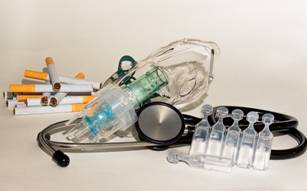People with Severe Emphysema May Breathe Better after EBV Therapy, Study Shows
A trial published in the American Thoracic Society’s American Journal of Respiratory and Critical Care Medicine reveals that a minimally invasive procedure may help patients with severe emphysema breathe better.
The study analyzes the use of a one-way valve that prevents air from entering diseased regions of the lung. This, in turn, enhances lung function and enables healthier areas of the lungs to expand.
 Previous studies highlighting the placement of the valves using a bronchoscope found that this therapy can be used as an alternative to lung volume reduction surgery. Patients with severe emphysema that participate in endobronchial valve (EBV) therapy “appear to experience similar improvements in lung function, shortness of breath, exercise intolerance and quality of life,” yet do not experience the occurrences of morbidity and mortality which have been associated with surgery.
Previous studies highlighting the placement of the valves using a bronchoscope found that this therapy can be used as an alternative to lung volume reduction surgery. Patients with severe emphysema that participate in endobronchial valve (EBV) therapy “appear to experience similar improvements in lung function, shortness of breath, exercise intolerance and quality of life,” yet do not experience the occurrences of morbidity and mortality which have been associated with surgery.
"EBVs have been shown to work in single center trials, but these studies tend to be performed at centers, and by physicians, with considerable experience, so the results may not be generalizable to other centers," said lead study author Samuel V. Kemp, MD, a respiratory physician and expert in interventional bronchoscopy at Royal Brompton Hospital. "What is interesting about this multicenter trial is that the results are at least as good as the single center studies, even though some of the investigators were new to the technique."
All study participants were ex-smokers over the age of 40 and had been diagnosed with severe heterogeneous emphysema. Out of the 97 participants, sixty-five received the valves and the remaining patients were provided with standard of care specific to each medical center's protocols for a patient that had received bronchoscopy.
Researchers discovered:
- After three months, 55.4 percent of the EBV group had a 12 percent improvement in FEV1, the amount of air that can be forcefully exhaled in one second, compared to 6.5 percent of controls.
- After six months, the percentage of those in the EBV group meeting the minimum FEV1 improvement was 56.3 percent, compared to 3.2 percent of controls.
- The average increase in FEV1 in the EBV group was nearly 30 percent.
- After six months, secondary endpoints among those in the EBV group were also clinically and statistically significant, including being able to walk nearly 80 meters longer in six minutes, retaining 750 fewer milliliters of air upon maximum expiratory effort, exhibiting less shortness of breath and reporting higher quality of life.
- The most common adverse event in the EBV group was a collapsed lung, which occurred in 29.2 percent of the patients.

